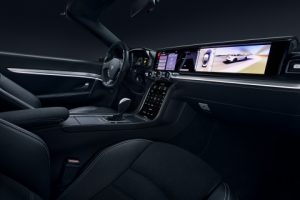
Automotive Infotainment cruises on high at CES
By Antonio Garzón, automotive semiconductor senior analyst, IHS Markit
Automation / Robotics Electronics Embedded Systems Engineering Software Wireless Engineering IoT automotive automotive Infotainment InfotainmentMain infotainment semiconductor and electronics trends observed at CES 2019
Infotainment and informational advanced driver assistance systems (ADAS) are converging in a digital cockpit with multiple voice assistants, impressive displays, electronic mirrors, driver monitoring cameras and new ways of interaction.

Trends for Automotive infotainment systems were on display at CES.
Here are the main infotainment semiconductor and electronics trends observed at CES 2019 in Las Vegas:
- Heterogeneous multicore systems on a chip (SoCs): Although still not automotive-grade, the new Qualcomm Snapdragon 855 with neural processing unit was featured in a cockpit concept featuring camera-based emotion recognition. Following Qualcomm´s automotive success with SoCs originally designed for mobile phones, Mediatek showed telematics and infotainment applications featuring the Autus processors T10 and I20, which will likely be available in new cars by the end of this year. The new Exynos Auto V and T series for infotainment and telematics were also exhibited, right after Samsung announced its first automotive design win with Audi in 2020. Traditional automotive SoCs from Renesas, NXP and Texas Instruments were also found in multiple development boards, especially the R-Car H3 starter kit (Salvator). While Intel´s automotive portfolio is struggling to compete against the dominance of ARM, the Atom Apollo Lake processor was reportedly used in concepts exhibited by BMW, Harman, Green Hills Software and other key players. Finally, AMD made headlines with its 7 nanometer announcements for gaming, mobile and servers, but no products were unveiled to confirm the rumors of an incipient automotive business line.
- Networking: Transferring video between cameras, displays and electronic mirrors will demand serializers and deserializers (SerDes) and faster multimedia interfaces, domains where Texas Instruments and Maxim Integrated featured their leading products. Valens was very active this year, announcing collaborations with Denso, Mitsubishi Electric, Aptiv and other top players, to implement its HDBaseT high speed networking solution, which should start gaining momentum next year.
- Connectivity: Vehicle to everything (V2X) was a key discussion topic this year, with the cellular versus 802.11p battle still ongoing. Although many are advocating for 5G everywhere, it will surely take some time to deploy, and companies like Valeo showed telematics modules with both dedicated short-range communications (DSRC) and cellular V2X (C-V2X) using the Autotalks second-generation chipset. A 3-in-1 combo wireless SoC with 802.11ax (Wi-Fi 6), 802.11p (DSRC) and Bluetooth 5/BLE, which was first introduced by Marvell last year, is expected to be found in vehicles from 2020.
- Security: Due to growing connectivity and over-the-air (OTA) updates, hardware security is quickly becoming a crucial part of every vehicle. The following devices were exhibited by NXP, Marvell, Maxim Integrated, STMicroelectronics and Microchip, usually in collaboration with software solutions from Arilou, Argus, Green Hills Software and others: secure controller area network (CAN) transceivers, Ethernet switches, authentication integrated circuits (ICs), trusted platform modules (TPMs) and microcontroller units (MCUs) with an embedded hardware-security module (HSM) for tamper-resistant telematics.
- Software: Microkernels and hypervisors from QNX, Green Hills, OpenSynergy, Wind River, Elektrobit and increasingly open source (Xen, ACRN) are now ubiquitously employed to separate the safety-critical (ASIL-B) real-time operating system used in the instrument cluster and the infotainment applications typically running on Android or Linux. Every layer of the software architecture – including cloud (and soon IoT) – is becoming an essential part of secure and high-performance infotainment.
- Sensors: Capacitive fingerprint recognition to open the car doors and start the engine will become real this year in cars from Hyundai. Other brands also demonstrated innovative sensor applications at CES: Kia presented camera-based gesture control for the in-vehicle experience; Texas Instruments applied mmWave radar for vehicle occupant detection and to enable opening the sunroof with a hand wave; and ROHM Semiconductor proposed to monitor heart rate with an optical sensor. Ultrahaptics uses an ultrasound transducer array to produce haptic feedback on the air, a disruptive interaction method that could be implemented in premium human-machine interfaces before 2025. Thanks to companies like Murata and ROHM Semiconductor, microelectromechanical systems (MEMS) accelerometers and gyroscopes continue to improve their accuracy and high-precision positioning units will be installed in cars very soon.
Advertisement
Advertisement
Stories continue below
